

Classic Buses Profiles
London trolleybus withdrawal programme 1959 - 1960 (by Dick Gilbert)
Last updated 30 November 2021

SOME LINKS WITHIN THIS WEBSITE: Home Email Links THE COMPLETE WEBSITE MENU Events Diary Halfcab list Small-Ads Classic Irish Buses Classic Manx Buses
This is a little bit of sad nostalgia drawn from the pages of the London Transport Magazine in 1959/ 1960, concerning the progressive withdrawal of trolleybuses, and the introduction of AEC Routemasters in their place.
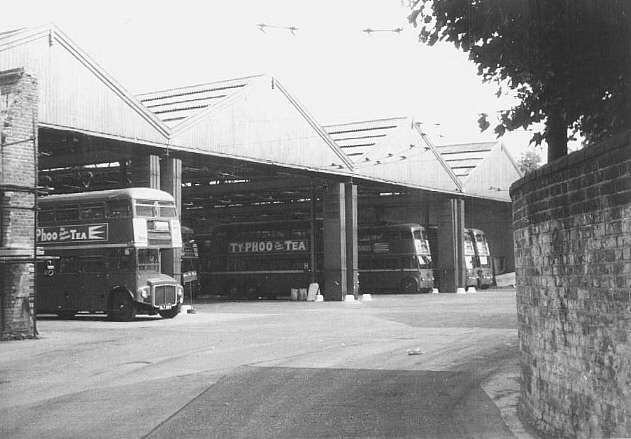
This photo was kindly sent by Alan Kenny. It aptly represents the topic of this page as it shows Routemaster RM254 on driver training duty at Finchley trolleybus depot on 22 July 1961. Forty plus years later, the Routemaster was fading into London's history, as the trolleybuses were when this picture was taken.
I came across about a dozen copies of the London Transport Magazine for 1959 and 1960 at a transport rally some years ago. This publication was a staff magazine which contained company news, employee profiles, jokes and cartoons that would be considered highly incorrect these days, and details of the activities of the many social organisations within LTE at that time. It was printed in sepia, which gives the volumes a very dated appearance, but I have chosen to reproduce the pictures here in black and white, as they turned out a bit clearer that way.
One ongoing story during this period was the progressive withdrawal of trolleybuses from around the network and their replacement with brand new AEC Routemasters. This process took place over several years, and the summer of 1960 marked its halfway stage (the last routes were closed down in May 1962). The following pictures and items record the progress of the conversion over an 18-month period, with little portraits of the characters involved, their memories of operating the trolleybuses and their thoughts on the diesel replacements. Please note that the dates refer to the issue of the magazine and not the date of the events recorded. News items are reproduced verbatim (though not always complete), and the italic comments in brackets are by me.
September 1959
Farewell to no. 1669
Charlton staff bid farewell as number 1669 - the last trolleybus to be overhauled at the workshops there - leaves for its final spell in service before the completion of the conversion scheme. A tram and trolleybus repair centre for more than 40 years, Charlton is to close shortly.
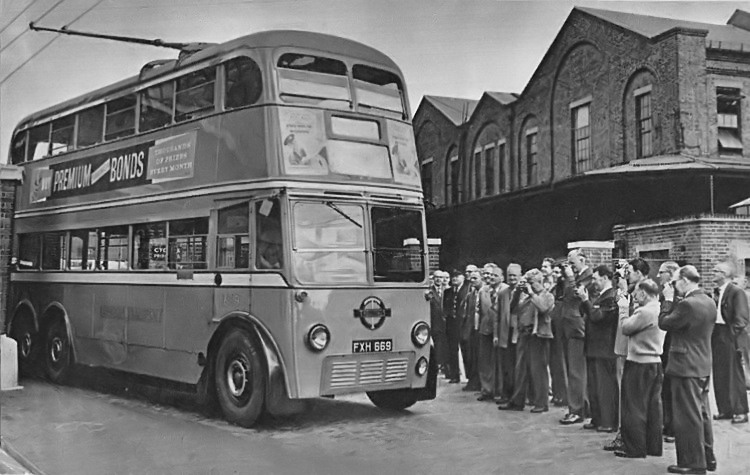
(No.1669 was the last in the N2 class of 25 trolleybuses first delivered in June 1940. They were numbered from 1645 to 1669 (FXH 645-669), with chassis by AEC and bodywork by Park Royal)
December 1959
The trolleybus conversion story
Last month saw yet another stage of London's £10 million trolley to diesel bus conversion scheme carried through successfully. Three major East London trunk services were involved; Poplar depot made the complete change to diesel operation, West Ham was partly affected; for the first time a fleet of bright new Routemasters took the place of the 20 year old trolleybuses.
But these are only the bare facts of the story. In reporting this fourth stage of the conversion it is to the human side that we turn for our story. For the crews, maintenance men and bus officials, the conversion marked the end of an era which holds many memories for them, for many it marked a big change in their work, for the older men in particular it marked a personal achievement.
Gleaming RMs take over
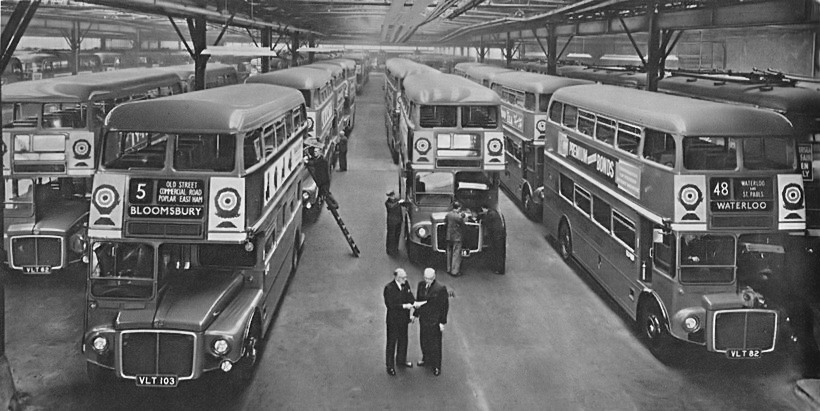
Routemasters lined up at Poplar ready for the big day. (Left to right are RM 62, 103, 66 and 82. RM 82 was to be the first Routemaster to operate a service from Poplar on 10 November 1959. Note the roofs of trolleybuses stored in the background, left and right.)
Men for whom the conversion has meant major changes, are the staff of the rolling stock department who maintain and service the vehicles. For some months past they have been working with building operations going on all around them - the installation of fuelling points and oil tanks, and the modification of workshops and repair pits. Add to this a fortnight back to school to learn their new job, then the arrival of a fleet of new vehicles - a somewhat awe-inspiring sight at first. They had every justification for being thrown a little off balance.
Few regrets
But when we spoke to the engineering staff at Poplar we found only plenty of smiles and few regrets. "They have adapted themselves quite well" reported divisional inspector George Buck. His job, in the north-east division has been to train trolleybus staff in the new maintenance routines. He stays for three weeks after conversion to see things running smoothly, then moves on to the next depot on the conversion list and begins all over again.

George Buck, divisional maintenance inspector.
Among the crowd who welcomed in the beflagged no. 1464 was senior instructor Edward Wallis. He has seen the full cycle. He trained the Poplar men to drive trolleybuses in 1940, and saw the first one into service. Now he is superintending diesel conversion training, assisted by instructor William Wright and a team of Chiswick instructors.
How are the trolleybus men taking to bus work? "They are doing remarkably well and have taken to bus driving in an expert manner" says Edward Wallis. He began training Poplar and West Ham men last March. Each of the drivers, many of whom were over sixty, was given an eleven day training course. Then they took the diesel bus driving test for the passenger service vehicle licence.
Big success
The great majority passed first time. The few who did not were all successful in their second test. Those whose training came early in the programme were given refresher runs to keep their hand in. "The keenness and determination of the drivers plus the patience and perseverance of the driving instructors has helped to make the change a hundred per cent success."
At the wheel of the first day service bus to leave Poplar was 62-year-old John Manley. He set out at 3:45 a.m. for Barking on new service no. 5, then returned to Bloomsbury. He has served forty years at Poplar, and is one of a number of sixty-year-olds who passed the P. S. V. test without turning a hair.

John Manley, driver, Poplar.
Good points
"I feel quite confident about bus driving," he said. "I managed the training comfortably and it didn't worry me. I think the bus is easier to drive. With a trolleybus your thoughts have to be divided fifty-fifty between the overhead and the ground." A woman's point of view on the new bus came from Mrs. Elsie Beddow of Poplar. "Two good points for me are the heaters and the extra wide gangway." Mrs. Beddow became a conductor as a war-time job in 1941, a few months after London Transport began to take on women for the job. She had a narrow escape when a bomb landed near her bus in Silvertown and blasted the windows out. "When I joined I never intended to stay beyond the end of the war. But here I am."

Elsie Beddow, conductor, Poplar.
Blitz times
The days when trolleybuses kept public transport going in blitzed East London were recalled by chief depot inspector Albert Creasey, the guv'nor to the crews at West Ham. When incendiary bombs rained down on the depot he was one of a number of volunteers who went in among fiercely blazing buses to rescue such vehicles as they could. Not only were buses burnt out in the depot sheds, but others were hit in the streets - their crews killed. Many was the morning after a night's bombing when vehicles went into service without a pane of glass in the windows.

Albert Creasey, chief depot inspector, West Ham.
West Ham was dealt its severest blow when a flying bomb scored a direct hit one Sunday. But hardly had the rubble been cleared when another of the V1s hit the garage - a week later to the day. "But we never stopped running the buses" said Mr. Creasey. "Our vehicles continued to provide the major services to the Royal group of docks come what may. There is no doubt that they played a vital part in the war effort."
Tragic loss

Tom Patterson, driver, Poplar.
Oldest of the trolleybus men to pass out successfully was driver Tom Patterson, aged 67, of Poplar. "I am quite happy about the change," he said. Tom has driven through the air raids of two world wars and witnessed from the platform of his tram the first Graf Zeppelin shot down over London. He also recalled the tragic loss of one of his mates, conductor J. Allen, who was killed by a landmine which fell outside Poplar depot. "I was just on my way out to meet him at the time."

Frederick Caunter, trade union secretary.
One of the Poplar men who took part in that earlier conversion in 1940 from trams to trolleybuses is Frederick Caunter, trade union secretary. "It certainly was a big change going from a vehicle on rails to steering yourself. But after twenty years at the wheel the change this time is not so drastic." One change for the trolleybus men will be to drive on routes penetrating the central area. "I reckon we have pretty tough traffic conditions on our trolleybus runs. East End or West End - there's nothing to choose between them. The traffic may be trickier in the West End, but we have been among the slow, heavy vehicles for years, and you need to be very careful with them."
ACRES RASED
Poplar depot inspector John Hooke, who has worked in the depot office for more than twenty years, was often on night duty during air raids. He recalls: "We had bombs all round us. One night the gas works was ablaze and a school on the other side. On another occasion a landmine laid waste the row of cottages outside the entrance. We thought we must surely get a direct hit one day. But it never came."

John Hooke, depot office, Poplar.
If you have never seen blitzed East London, even all these years afterwards, just take a walk around Poplar. Acres of cottages were rased to the ground. Yes, it was certainly lucky Poplar depot.
A procession
Driving one of the new RMs out of West Ham brought back memories of his days on the open-fronted trams for Albert Riddle. "Strangely enough, you didn't get the colds then. I used to wrap up in a big Scotch wool scarf." His verdict on the current change to diesels: "Bus driving is a relief after the trolleys. They had two big drawbacks - the overhead and overtaking. You could go over a junction a hundred times without mishap, then the next time, moving just as carefully, the poles would come off. When traffic was bad you could not overtake each other. The trolley services became a procession."

Albert Riddle, driver, West Ham.
The last warrior
West Ham took its first changeover quietly enough, for only thirteen buses were involved. But at Poplar November 10 was the cue for a big celebration. Frederick Caunter, branch secretary of the Transport and General Workers Union, and Charles De Courcy, social secretary, pooled their resources and set the scene for a grand farewell party and dance.
More than four hundred busmen and their families were present in the depot's large recreation hall. The dancing went with a swing; a popular feature - the free bar.
There were cheers and handshakes for driver John Tilley and conductor Edward Barrett when they took out the first Routemaster at 11.47 p. m. It was RM82 bound for Charing Cross on night service 284.
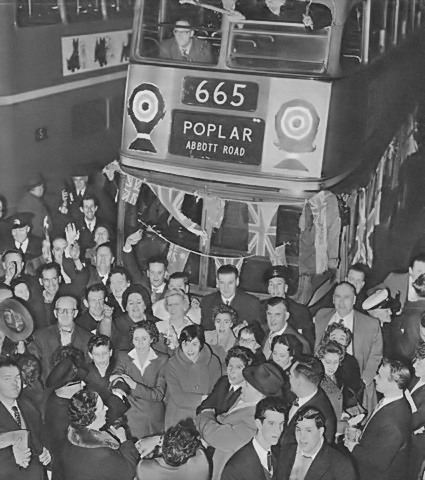
At 12.30 p. m. the party broke up for the great moment - to welcome home Poplar's last old warrior. A procession of busmen carrying lighted flares led the way as no. 1464, garlanded with flags, came slowly in. At the wheel was Frederick Burns, with Richard O'Neill as conductor.
"You mustn't miss the last bus home," sang the crowd. Then - "Keep right on to the end of the road" as the last trolleybus slowly drove down the ranks of Routemasters. As the last chorus of Auld Lang Syne died away, engineers stripped off the flags and switched out the lights. No. 1464 was en route to the scrapyard.
(No.1464 was one of the large L3 class, consisting of 148 AEC trolleybuses with Metro Cammell Weymann bodies. They were delivered in 1939 and had the registrations FXF 380 and FXH 381-529. It was one of this batch - no. 1521 - that was the very last trolleybus to operate in London, in May 1962. You will be bored to know that my records show I saw 75 of this class in service, including 1464 and 1521.)
Facts and figures
February 1960
First and last on the trolleys is ambition of driver Hadland
Fulwell depot saw the first of the trolleybuses in London. It will also see the last of them. Its history, which stretches back nearly sixty years, is packed with interesting events and personalities.

A transport ambition is cherished by driver Ronald Hadland, one of the veterans at the depot. He wants to be at the wheel of the last trolleybus to run in London. If he achieves his wish - and he stands a good chance of doing so - driver Hadland will hold an indisputable record as the man who served longest on trolleybuses.
Nearly thirty years ago Ronald Hadland was chosen to be the conductor of the first trolleybus, a no. 4, which opened the service between Teddington and Twickenham. He was selected for his smart turn-out. "I used to be a shining example in those days," he commented. "I spent two hours every day cleaning my uniform and had cuffs gleaming like patent leather and buttons twinkling like stars."
First he took a show bus into Twickenham for an official opening of the service by the mayor of that town; then drove the leading vehicle on the six-mile round trip which operated from Fulwell. As the first trolleybus moved out of the depot, district inspector Charles Gilbert jumped aboard and paid a penny for the first ticket from conductor Hadland.
(In fact it seems Ronald Hadland did not achieve his ambition, as the driver of the last trolleybus on 8 May 1962 was Albert West, Fulwell's oldest driver at age 70. In August 2002 I received an interesting email on this subject from Tony Denton as follows:
"Dear Dick, I was very interested in your section on the London trolleybus conversion programme from the L. T. magazine. Driver Ronald Hadland was on the main tours the previous weekend before closure. Although he did not drive the last trolleybus 1521 into Fulwell garage, which came up from Hampton Court, he was standing on the platform (I was hanging on to the rear). Another 40 year-old question solved. Yours sincerely, Tony Denton. P. S. He was a real gentleman, always interested in what all the enthusiasts were doing."
Indeed, it seems Ron Hadland (who had been conductor on the first London trolleybus on 16 May 1931) was the conductor on diddler no. 1 when it was resurrected for a ceremonial run from Twickenham to Kingston and back on the afternoon of 8 May 1962, the last day of trolleybus operation in London.
In May 2004, I received an interesting mail from Ken Tuddenham, as follows:
"I have just found your very good site and I have a few memories of Ron Hadland, and I did a few tours with him as well. I was the driver of 1521 on the special run behind no. 1 in the afternoon. I was reunited with 1521 at Carlton Colville to celebrate 30 years after withdrawal, and was interviewed for the video of the event. Just thought you might like this little bit of info. Regards, Ken Tuddenham.")
APRIL 1960
100 new RMs take over five trolleybus routes
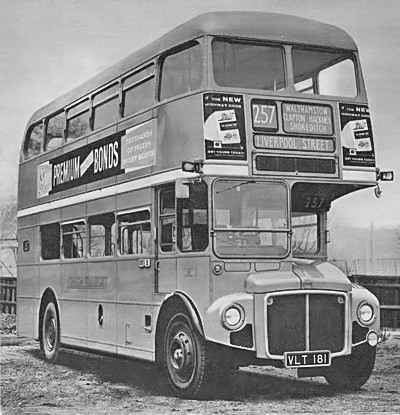
The latest version of the Routemaster, taken a fortnight ago.
The disappearance of all London trolleybuses east of the River Lea is the main feature of stage six of London Transport's £10 million conversion scheme, which takes place on April 27. A hundred new Routemaster buses will take over five trolleybus routes - 623, 625, 687, 697 and 699, and the inhabitants of Chingford, Walthamstow, Woodford, Leyton, Stratford and West Ham will see their last trolleybuses on the Tuesday night.
Altogether 45 miles of trolleybus services will be replaced including, for the first time, two routes in north London, serving Tottenham, Manor House, Wood Green and Winchmore Hill. This, the most widespread changeover so far, will enable London Transport to replan bus services throughout the area.
This month's changeover means a final goodbye to trolleybuses at West Ham and Walthamstow depots. Both were once the headquarters of municipal tramway systems.
Some of the older staff will be switching to Routemasters, having earlier in their transport careers changed from trams to trolleybuses.
West Ham has already made two partial changeovers from trolleybuses to diesels at intervals of three months. Walthamstow began operating Routemasters in February. Now it loses the final 44 trolleybuses.
Staff at both depots are planning to stage celebrations to mark the end of the trolleybus era. The last trolleybuses to run in will, it is expected, be garlanded for the occasion.

Two of the services affected will be 623 and 625, which run for their last mile of their routes through Epping Forest to the terminus at the Napier Arms, Woodford. The trolleybuses among the trees provide one of the more unusual sights of London. From April 27 it will be no more.
June 1960
Welcome and farewell
In stage six of the trolley-to-diesel conversion recently a further forty five miles of the old-style services were replaced. Five routes were affected (623, 625, 687, 697 and 699); West Ham and Walthamstow depots lost the last of their trolleybuses, and Wood Green made a partial changeover. In this special feature we tell the story of the last night at one of the depots and interview some of the people involved.
Led by a two-man band and a procession bearing flaming torches, West Ham's last trolleybus, beflagged and packed to capacity, moved slowly through the deserted streets of East London. At twelve minutes past midnight a large crowd had gathered at the depot gates.
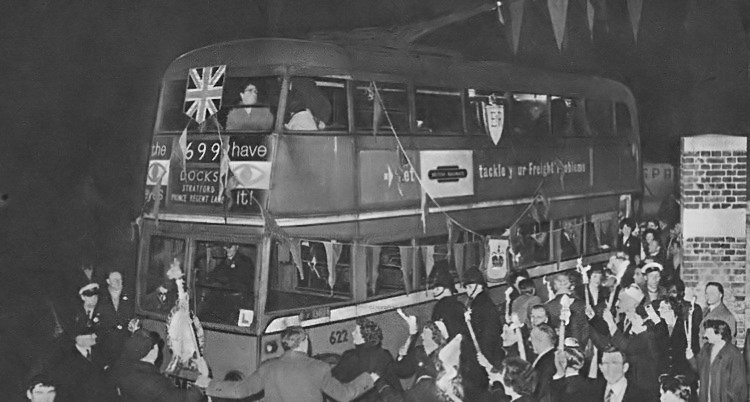
No. 622 arrives at West Ham depot.
(No. 622 was one of the early E2 class of 25 AEC trolleybuses delivered in 1937. They were numbered 604-628 (DLY 604-628) and had bodywork by Park Royal.)>
Aboard the ceremonial bus - number 622 - the mayor of West Ham, Mrs. Violet Ayres, was trying her hand at issuing tickets from a Gibson machine. It was the last journey from the Docks terminus of route 699. Twenty three years earlier another woman mayor, Mrs. Daisy Parsons, had driven no. 622 out of West Ham depot - at 6.30 in the morning. In the years between, number 622 has run some 900,000 miles. It had led a gruelling life on the streets of London, operating day in and day out, sometimes for as many as fourteen hours out of the twenty four.
That is the record of most of London's trolleybuses, and they are now showing signs of wear and tear that are growing ever more costly to repair. The vehicles are being scrapped and replaced by smart new Routemaster diesel buses. These 64 seater vehicles are 8 feet wide, giving a wider gangway, and have heaters on both decks. For the driver there are automatic gears and power-assisted steering.
End of an era
It was the end of a transport era at a depot which has always displayed a particularly proud spirit - stemming from its days as headquarters of the local municipal tramway system. "It just won't seem the same without the trolleybuses.... They are part of the scenery in East London.... They have given good service and we have grown fond of them.... Sorry to see them go, but the new Routemasters certainly give a good ride...." Those were some of the sentiments of local people on the last night.
Inside the depot, the last night was the signal for the brightest party seen there for many a year. Crowds packed the floor at a dance in the canteen. Among those present at the party we found some veterans who had seen the trolleybus era through from start to finish. George Curran, aged 59, recalled the morning in 1937 when no. 622 was the first trolleybus to go into service from the depot. He was the conductor on the ceremonial trip. "Mrs. Parsons, the mayor, was issued with a special licence so that she could drive the trolleybus," he said. "She steered the vehicle, which was running on its batteries, from the depot to the Green Gate tavern. There was a great demand for my tickets as mementoes. They were numbered A and four noughts in each value."
While the party went ahead the night engineering staff were at work. Having prepared the Routemaster fleet for the morning run out, they were now cleaning their trolleybuses for the last time as they came off the road. All the West Ham destination blinds were then removed and the vehicles were lined up for an overnight move. 54 were going to Highgate to replace other vehicles in service. Ten would go to Edmonton en route to the breaker's yard.
A special feature of the night's vehicle moves was that more than 65 RT type diesel buses were being transferred to West Ham from Forest Gate garage, which was to close as part of the general replanning of services in the area. The Forest Gate crews would be running into their garage for the last time. In the morning many of them would report for duty at West Ham.
At the wheel of trolleybus no. 622 on its last run was driver John Hall, aged 59. His conductor was Frederick Yates, both of them former West Ham tram men. "I must admit I love the old trolleybuses," said John Hall. "They have been the finest of vehicles, so quiet and roomy. But there was always a drawback in the overhead system, and they caused congestion."

The Mayor of West Ham, Mrs. Violet Ayres, issues a ticket on the ceremonial last run from the docks. On the left is conductor Frederick Yates.
September 1960
Halfway house - stage seven
The halfway mark in London's trolleybus-to-diesel bus conversion was passed successfully at the seventh big changeover night recently. Four routes were concerned in the overnight switch in the type of vehicle. They were 626, 628 and 630, running between Croydon, Clapham, Hammersmith, Harlesden and Acton, and route 611 operating from Highgate to Moorgate. For our rolling stock engineers it was the trickiest changeover so far - one that called for smart work from the staff at Hammersmith depot and neighbouring Shepherds Bush garage.
It was a triple move round. Trolleybuses ran into Hammersmith at the end of the day's work and were then driven off to one of half a dozen other trolleybus depots by engineering staff. This process began at 7 p. m. and gathered momentum as the evening wore on. As this task proceeded, other engineering crews drove the fleet of 44 airport coaches to Hammersmith from Shepherds Bush, after they had been cleaned and serviced there for the last time. These coaches began returning to service late the same evening to cater for night flights from London Airport.
Meanwhile, staff at Shepherds Bush were preparing the fleet of new Routemaster buses which were to take over the duties of the trolleybuses the next morning. The final ten of the new buses arrived only that evening. Our pictures tell the story of the night's main events....

Crowds welcomed the last trolleybus to arrive at the Hammersmith depot - vehicle no. 1121, which made the final run on route 628 from Clapham Junction. Trolleybus staff carrying torches met the vehicle at the depot gates. It was 25 years old and had run nearly one million miles. But for good measure they sent it round the Broadway once again.
(No. 1121 was from the first batch of one hundred K1 class trolleybuses delivered in 1938. They were numbered 1055 to 1154 (EXV 55 to EXV 154) and were of all-Leyland construction. A further batch of 50 K1s was delivered the following year. My spotter's notebook says that I saw 22 of these in service, but not no. 1154. Note one of the BEA coaches on the left. They were moved into Hammersmith garage as the trolleybuses were moved out.)

No sooner had no. 1121 run in, than a tower wagon from Fulwell moved across to begin cutting down the overhead power lines. Other overhead crews were busy through the night moving junctions and isolating wires along the routes affected in the changeover.
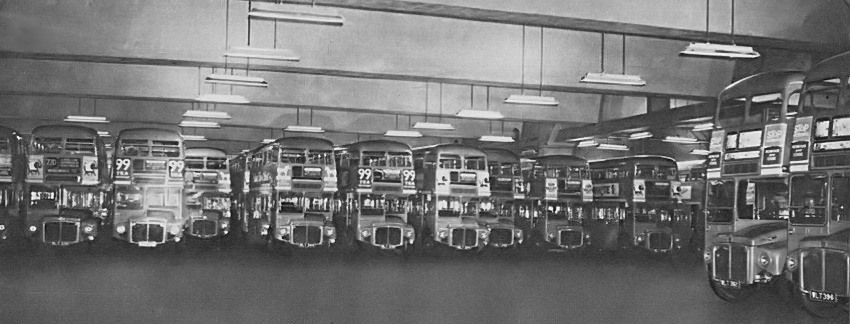
Waiting to take the place of the trolleybuses..... a shining array of new Routemasters at Shepherds Bush garage. A fleet of 44 B. E. A. airport coaches formerly housed here were transferred during the evening to Hammersmith depot, now their new home.
(Numbers visible in this picture are RM392 and 396 on the right, and RM344 just left of centre with the White Horse adverts.)
December 1960
The RM takeover - eighth stage
Nearly 60 years ago crowds at Shepherds Bush cheered the capital's first electric trams into service along Uxbridge Road. Last month the people of West London gathered along this historic traffic route once again - to bid farewell to the trolleybuses, successors to the trams, as they ran for the last time.
It was the 8th stage of London Transport's trolleybus to diesel bus conversion scheme. It was the end of nearly sixty years of electric traction along all but a short section of this twelve mile traffic route. First there were the red-and-white painted London United trams, the capital's first electric trams. They were a sensation during the Easter of 1901. Later came the streamlined Feltham trams, the acme of comfort in their day and specially designed for this long, fast route. Since 1936 there have been the trolleybuses. Transport had moved forward with the times once again. At Hanwell the old tram shed had been demolished and replaced with a new depot to house a new fleet of trolleybuses. Acton depot was closed.
For 24 years, almost to the month, the trolleybuses pounded up and down the route. Many of these vehicles, now at the scrapyard, have clocked nearly a million miles. They, in turn, have had to be replaced. Hanwell depot, still spacious and modern in appearance, has been adapted to house and service its new fleet of diesel buses.
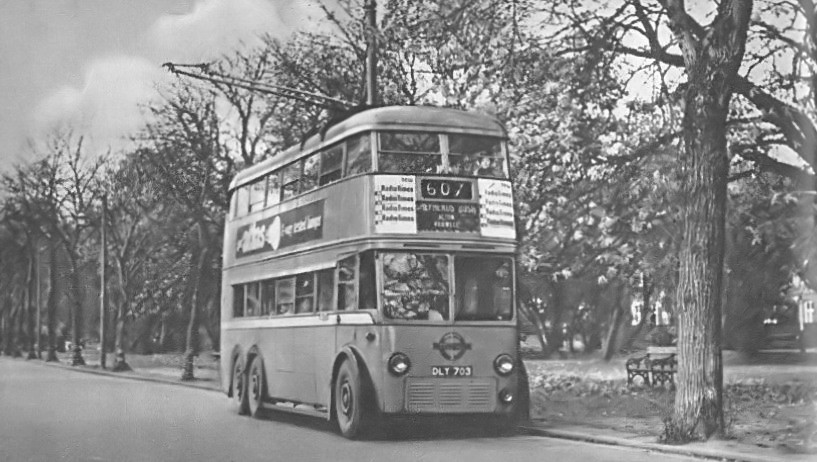
No. 703 from Hanwell depot.
(No. 703 (DLY 703) nears the end of its days on route 607 through Ealing Common. This was a Leyland /MCW trolleybus of class F1, delivered in 1937. There were 100 in the batch.)

Farewell night at Hanwell, with new RMs ready to take over the next day.
That's it folks ! The story carried on like that for another eighteen months. If you remember all this, please e-mail me about it, and I'll be happy to post your letters on the mail and news page. Hope you got this far and enjoyed it.
For more London buses see the AEC Regal T class, the Leyland Tiger PS1 TD class, the AEC Renown LTL class scooters, the Routemaster, the DMS Fleetlines, and the exported AEC Swifts in Malta.
For a comprehensive list of Trolleybus sites, visit the trolleybus webring.
Here is some film of London trolleybuses in service (PMP Video).
For many other buses, have a look at all the other profiles on the Classic Buses menu page.
SOME LINKS WITHIN THIS WEBSITE: Home Email Links THE COMPLETE WEBSITE MENU Events Diary Halfcab list Small-Ads Classic Irish Buses Classic Manx Buses